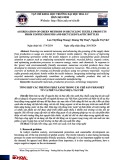
ISSN: 2615-9740
JOURNAL OF TECHNICAL EDUCATION SCIENCE
Ho Chi Minh City University of Technology and Education
Website: https://jte.edu.vn
Email: jte@hcmute.edu.vn
JTE, Volume 19, Special Issue 05, 2024
101
Natural Fibers from Vietnam Coffee Grounds as a Potential Reinforcement for
Biocomposite Materials
Duong My Tien Phan1, Thanh Qui Pham1, Chi Thanh Nguyen2*
1Huynh Man Dat High School for the Gifted, Rach Gia City, Kien Giang Province, Vietnam
2Ho Chi Minh City University of Technology and Education, Vietnam
*Corresponding author. Email: thanhnc@hcmute.edu.vn
ARTICLE INFO
ABSTRACT
Received:
16/12/2024
Coffee grounds were a common agricultural byproduct available in large
quantities in many countries, containing a relatively high cellulose content
of approximately 26.6–31.3%. Extracting cellulose fibers from coffee
grounds was therefore both economically and environmentally significant.
This study aimed to extract cellulose fibers from coffee grounds using a
non-toxic and cost-efficient alkaline hydrogen peroxide extraction method.
Scanning electron microscopy (SEM) analysis results indicated that, after
being dried, the cellulose fibers tended to aggregate into bundles, with no
individual fibers observed. The extraction yield was found to be 63.24%.
Fourier transform infrared (FTIR) spectroscopy analysis revealed
absorption peaks at wavenumbers corresponding to O-H, C-H, and C-O-C
group vibrations, characteristic of the chemical structure of cellulose. The
crystallinity index determined by X-ray diffraction (XRD) technique of the
extracted cellulose fibers was 38.9%, higher than that of the raw coffee
grounds. Thermogravimetric analysis (TGA) result indicated that the
thermal stability of the obtained cellulose fibers was relatively lower than
that of the coffee grounds. The obtained cellulose fibers have potential
application as a reinforcing agent for biocomposite materials.
Revised:
19/12/2024
Accepted:
20/12/2024
Published:
28/12/2024
KEYWORDS
Agricultural waste;
Coffee grounds;
Cellulose fibers;
Alkaline hydrogen peroxide;
Green extraction.
Doi: https://doi.org/10.54644/jte.2024.1746
Copyright © JTE. This is an open access article distributed under the terms and conditions of the Creative Commons Attribution-NonCommercial 4.0
International License which permits unrestricted use, distribution, and reproduction in any medium for non-commercial purpose, provided the original work is
properly cited.
1. Introduction
Agriculture plays a crucial role in Vietnam’s economy, with coffee being one of its key agricultural
export products. According to the Ministry of Agriculture and Rural Development and VICOFA
(Vietnam Coffee and Cocoa Association), Vietnam's coffee production for the 2023-2024 crop year is
approximately 1.47 million tons, with about 1.43 million tons for export [1, 2]. On average, each cup of
coffee requires 20 - 25 g of coffee beans. After brewing, coffee grounds account for approximately 40-
50% of the initial weight of the coffee beans [3]. Currently, most coffee grounds are either used for low-
value purposes or discarded into the environment, leading to water and soil pollution and disrupting soil
microorganisms [3, 4]. Utilizing this abundant agricultural waste to produce high-value materials having
potential applications in various fields holds significant scientific and practical importance. It helps
address the environmental pollution caused by coffee grounds while also offering economic benefits.
The coffee roasting process typically occurs at temperatures ranging from 180 – 240 °C, and when
the coffee is brewed (with hot water at around 90 °C), neither the coffee beans nor the cellulose in the
coffee grounds undergo thermal degradation [5]. Coffee grounds contain components such as: moisture
content below 10%, approximately 7.83% inorganic matter, about 2.87% fats and oils, around 18.07%
fiber, 17.32-18.29% lignin, 20.92% hemicellulose, and 26.60-31.26% cellulose [4-6]. Depending on the
soil conditions and the type of coffee, the chemical composition of coffee grounds can vary in their
proportions.
Cellulose is the most abundant natural materials, with an annual production of 10¹¹–10¹² tons/year
[7]. It is a polysaccharide with the molecular formula (C₆H₁₀O₅)ₙ, composed of numerous β-glucose units




























